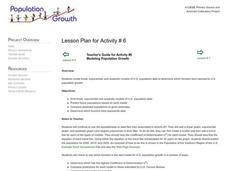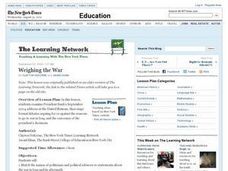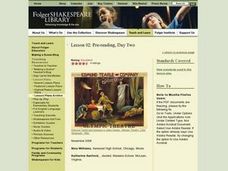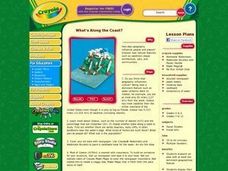Curated OER
Modeling Population Growth
Students create linear, exponential, and quadratic models of U.S. population data to determine which function best represents U.S. population growth. They predict future populations based on each model.
Curated OER
Weighing the War
Study opposing viewpoints with this lesson, which examines President Bush's September 2004 address at the United Nations. Middle schoolers study the text of the address, and then stage formal debates arguing for or against the reasons to...
Curated OER
Scientific Method Experiment: Factors Affecting How Ice Melts
Students demonstrate the scientific method by conducting an ice cube melting experiment. They make predictions and observations, and conclude what factors make ice melt more slowly or quickly than normal.
Curated OER
Factors Which Affect the Rate of Chemical Reactions
Students complete an experiment with Alka-Seltzer and reaction rates. They control the rate in which gases are allowed to escape. They test their predictions and observe what happens during the experiment.
Curated OER
The Effects of Temperature on Rate
Students create predictions on what they believe happen to reaction rates when temperature is raised. They use hot, cold, and room temperature water for this experiment and observe the differences. They graph their observations and...
Curated OER
Magic Wands and Wand Holders
If you were a fairy and had your very own magic wand, what would it look like? Little learners get to create a magic wand and holder of their very own, using paint, ribbon, and wood. Magic wands can be used when making story predictions,...
Curated OER
Shakespeare: Julius Caesar
Before your high schoolers read Julius Caesar, have them complete this thought-provoking activity! To familiarize them with some of the play's most important lines, break the class into pairs and have them create a skit around two lines...
Teach Engineering
Determining Densities
Don't be dense—use a robust resource. The second installment of a five-part Floaters and Sinkers unit has learners determine the densities of several objects. As part of the activity, they learn the displacement method for finding...
Curated OER
Pride and Prejudice, Chapter XIV: Lady Catherine and Elizabeth
Is your class reading Pride and Prejudice? In order to link scenes to the themes in Austen's novel, pairs take on the confrontation between Lady Catherine and Elizabeth (Chapter XIV). After writing their own version of the conversation,...
Curated OER
Oh, What A Day
Students listen as the teacher reads A Country Far Away. They predict what they will do and what they think their partner student will be doing. Students create a KWL chart for Japan. They collect information about their activities on an...
Alabama Learning Exchange
The Water Cycle
Learners identify the stages of the water cycle. They listen to the book "Magic School Bus: Wet All Over," examine the Build Your Own Water Cycle website, predict and measure the amount of water in a jar for a week, and read a short play...
Curated OER
Estimating Measurement
First graders estimate length and height of items. They read the story of Jack and the Beanstalk and discuss estimation of size. Students predict the length and height of figures. They use lines and numbers on the centimeter rod and tape...
Curated OER
Wellness and the Benefits of Exercise
Second graders discuss benefits of keeping physically fit, predict effects of exercise on their bodies, perform various exercises correctly, including push-up, curl-up, and jumping jack, discuss and follow safety practices while...
PBS
Button, Button
Youngsters count, classify, and estimate quantities using buttons after a read aloud of The Button Box by Margarette S. Reid. They discuss the difference between guessing and estimating. Based on an experiment, they predict the number of...
Curated OER
The Green Truck Garden Giveaway
Young scholars read "The Green Truck Garden Giveaway" and explore the hobby of gardening. After observing illustrations in the book, students predict possible events in the story. They discuss gardening and write a story about a...
Curated OER
Probability for the Novice
The comprehensive, overall purpose in teaching probability is to help young scholars draw conclusions about the characteristics of a large group given a small sample taken from the group. Probability is related to predicting the chance...
Curated OER
Probability and Statistics
Elementary schoolers choose from a host of activities to investigate probability and statistics. They complete worksheets, create 3-D graphs, and play graph bingo. They make weather predictions and list all the possibilities before going...
Curated OER
Pen Pals
Young scholars make their own predictions about the amount of different types of birds at each site before they go there. In groups, they collect the bird data and compose letters to their pen pals sharing their information. To end the...
Curated OER
Looking at Me-In the Future
Young scholars interview family members for important details and funny stories about themselves when they were younger. Once interviews are complete, they list interesting facts about their life today then predict what their life will...
Curated OER
What's Along the Coast?
Students research an area with at least one dominant geographical feature. Then they display their findings in a realistic 3-dimensional presentation. Students also prepare ancillary material to support their project. Finally, they chart...
Curated OER
What Would You Do?
Students explain how we all face tough decisions everyday. They show how they respond to those events reveals who they are and where they are in their character/moral development. Students predict how to deal with peer pressure and...
Curated OER
Human Population- Changes in Survival Rates Data Interpretation
In this human population changes in survival worksheet, students interpret and plot data to understand the differences in human mortality and survivorship between historic and modern times. They investigate how these changes influence...
Curated OER
Mass-Mass Relationships
High schoolers investigate mass-mass relationships using potassium carbonate and hydrochloric acid. For this mass-mass relationship lesson plan, students measure a certain amount of potassium carbonate and determine how much hydrochloric...
Curated OER
Mass-Mass Relationship
Learners investigate mass-mass relationships in the lab. In this mass-mass relationship lesson plan, students mix sodium carbonate with hydrochloric acid to produce sodium chloride, water and carbon dioxide. Learners use the amount of...
Other popular searches
- Making Predictions
- Predictions
- Predicting Outcomes
- Reading Predicting Outcomes
- Reading Making Predictions
- Make Predictions
- Pictures Story Predictions
- Lesson on Making Predictions
- Reading Predictions
- Story Prediction
- Predicting a Story

























